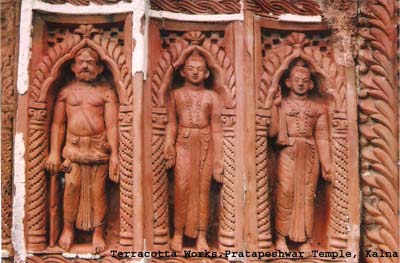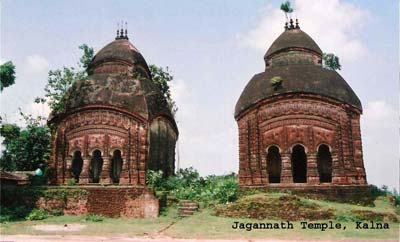AMBIKA KALNA – THE TEMPLE TOWN
 Located on the west bank of the Bhagirathi, Ambika Kalna (popularly known as Kalna) once flourished as a prosperous port town. Located on the west bank of the Bhagirathi, Ambika Kalna (popularly known as Kalna) once flourished as a prosperous port town.
It reached it's pinnacle of glory during the late 18th century under the patronage of the Maharajas of Bardhaman, who built several magnificent temples with intricate terracotta ornamentation. The maritime trade has long stopped and Kalna has lost the status of a flourishing port city, but the temples are still there reminding one of Kalna’s glorious past.
Apart from the temples Kalna has several religious structures dedicated to Sree Chaitanya one of the greatest social reformers of Bengal. Located just 82km from Calcutta, Kalna can be an ideal pilgrimage on any Sunday and double up as a trip back in time and back into the pages of history.
The Rajbari complex in Kalna has the maximum concentration of temples. Spread on either side of a metalled road the complex contains a unique mixture of Bengal’s temple architecture. On one side of the road lies the Nabakailas Temples. Built in 1809 by the Bardhaman Maharaja Tej Chandra Bahadur the complex contains 108 aat – chala (eight sloped roofed) temples arranged in two concentric circles separated by a well-maintained lawn with beautiful flowerbeds. The outer circle consists of 74 temples consisting of alternate black & white lingas while the 34 temples of the inner circle have only white lingas.
On the other side of the road lies a walled complex, containing the most diversified form of Bengal’s temple architecture. The star attraction of the complex is the Pratapeshwar Temple, with its elegant shape and rich terracotta ornamentation. Built in 1849 in Deul (Spire) style the temple contains terracotta plaques depicting themes of Hindu epic, mythical life of Sree Chaitanya, images of Durga & Ravana and various aspects of day to day life.
The other two star attraction of the complex are Lalaji Mandir & Krishnachandra Mandir. Both are three-storied Panchavimsatiratna (25 pinnacled). The Lalaji Temple is built in 1739 and is the oldest temple in the complex. It is fronted by a char-chala (four sloped roof) mandap. The temples also have some beautiful terracotta panels. The Krishnachandra temple built in 1751-55 is very similar in structure to the Lalji Mandir. The complex also houses several minor structures like a roofless Rash Mancha, several aat-chala structures among which a flat roofed temple of Giri Govardhan needs special mention.
Bhaduri-para also has a large collection of temples including the Panchavimsatiratna (25 pinnacled) temple of Gopalbari. But the holiest attraction of Bhaduri-para is the Siddheswari Temple, dedicated to the Mother Goddess Ambika or Kali. Built in 1740 AD by Chitra Sen, the then King of Bardhaman, this shrine is considered to be the most auspicious one in the town. The char-chala structure reached by a flight of 14 beautifully curved steps (signifying the 9 planets & the 5 tantric cults) houses the image of auspicious Bamakali Idol, built of a single neem log. The complex also contains three Shiva Temples. The nearby Ananta-Basudev Mandir is another interesting terracotta temple, but sadly only a few of the panels have survived the test of time.
Thus proving its uniqueness as a confluence of Shakti and Vaishnava forms of worship. Thus a trip to Kalna not only proves to be a unique pilgrimage but also doubles up as a gateway to the glorious days of Bengal’s temple architecture.
Travel Tips:
Getting there: Howrah – Katwa local (Howrah departure 07:53, Ambika Kalna arrival 09:48) Sealdah – Katwa local (Sealdah departure 07:57, Ambika Kalna arrival 10:30)
Getting around: Rickshaws are the only alternative. It takes 2 ½ to 3 hours for the entire trip. Charges are about Rs75 per rickshaw for the entire trip, but it is subject to heavy bargain.
Places to eat: The temples & pilgrimages of Kalna can be covered in a day. There are several places to eat. Hotel Priyadarshini, near the bus stand offers good food at reasonable prices.
Getting back: Katwa - Howrah local leaves Kalna at 16:20. Katwa – Sealdah local leaves Kalna at 17:20.
Travel Writer Rangan Datta can be reached at rangan_datta@yahoo.com
For history enthusiasts, we invite readers to our Contributory History Writing Project on Bengal – An Intimate History of Bengal or AIHB |

